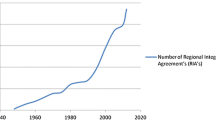Summary
A two-sector model for developing countries explicitly takes into account the influence of consumer goods rationing on the labour supply for market production and considers the effects of fiscal policy and exchange rate policy on the production of agricultural and urban goods. An increase in government expenditures depresses agricultural production. A devaluation may be counterproductive since it may lead to a decline in both the production of non-traded goods by raising the costs of imported inputs, and in the production of traded goods by affecting labour supply. Finally, import rationing may lead to a deterioration of the trade balance.
Similar content being viewed by others
References
Benassy, J.P.,The Economics of Market Disequilibrium, New York, 1982.
Bevan, D., A. Bigsten, P. Collier and J.W. Gunning,East African Lessons on Economic Liberalization, Thames Essay No. 48, London, 1987.
Barro, R.J. and H.I. Grossman, ‘A General Disequilibrium Model of Income and Employment,’American Economic Review, 61 (1971), pp. 82–93.
Branson, W.H., ‘Stabilization, Stagflation and Investment Incentives: The Case of Kenya, 1979–1980,’ in: S. Edwards and L. Ahamed (eds.),Economic Adjustment and Exchange Rates in Developing Countries, London, 1986.
Clower, R.W., ‘The Keynesian Counterrevolution: A Theoretical Appraisal,’ in: F.P.R. Brechling and F.H. Hahn (eds.),The Theory of Interest Rates, London, 1965.
Cuddington, J.T., P.O. Johansson and K.G. Löfgren,Disequilibrium Macroeconomics in Open Economies, Southampton, 1984.
Dornbusch, R., ‘Exchange Rates and Fiscal Policy in a Popular Model of International Trade,’American Economic Review, 65 (1975), pp. 859–871.
Krugman, P. and L. Taylor, ‘Contractionary Effects of Devaluation,’Journal of International Economics, 8 (1978), pp. 445–456.
Leijonhufvud, A.,On Keynesian Economics and the Economics of Keynes, London, 1968.
Malinvaud, E.,The Theory of Unemployment Reconsidered, Oxford, 1977.
Myint, H.,The Economics of the Developing Countries, London, 1980.
Neary, J.P., ‘Non-traded Goods and the Balance of Trade in a Neo-Keynesian Temporary Equilibrium,’Quarterly Journal of Economics, 95 (1980), pp. 403–429.
Patinkin, D., Money,Interest and Prices, New York, 1965.
Schultz, T.W.,Transforming Traditional Agriculture, Chicago, 1964.
Standaert, S., ‘The Foreign Exchange Constraint, Suppression of the Trade Deficit and the Shadow Price of Foreign Exchange in a Fix-Price Economy,’Journal of Development Economics, 18 (1985), pp. 37–50.
Stiglitz, J.E. and A. Weiss, ‘Credit Rationing in Markets with Imperfect Information,’American Economic Review, 71 (1981), pp. 393–410.
Wijnbergen, S. van, ‘Exchange Rate Management and Stabilization Policies in Developing Countries,’Journal of Development Economics, 23 (1986), pp. 227–247.
Zaidi, I.M., ‘Currency Depreciation and Nonclearing Markets in Developing Economies,’IMF Staff Papers, 33 (1986), pp. 276–303.
Author information
Authors and Affiliations
Additional information
The author would like to thank Professor W.H. Buiter, Professor J.W. Gunning, Professor H. Jager, and an anonymous referee for useful comments on an earlier version of this paper. I am especially grateful to Ger Lanjouw and Edmar Sprokholt for their stimulating remarks on the subject of this paper and for providing me with new ideas.
Rights and permissions
About this article
Cite this article
Lensink, R. A model of rural-urban conflict in developing countries. De Economist 140, 83–108 (1992). https://doi.org/10.1007/BF01849805
Issue Date:
DOI: https://doi.org/10.1007/BF01849805




